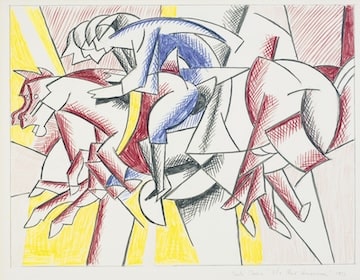The Red Horseman, 1974 by Roy Lichtenstein

Among the many subjects that form a cogent part of Lichtenstein's dialogue with art is the Italian twentieth century Futurist Carlo Carra's watercolor The Red Horseman, of 1913, which
formed the basis for the artist's monumental canvas Red Horseman. Lichtenstein uses an image that symbolized the Futurist movement, especially its fascination with the dynamics of speed
and its unequivocal glorification of war. Unlike his earlier cartoons, in which World War II was viewed as a just cause, Lichtenstein's Futurist paintings sidestep the political ramifications
of a group of painters who acclaimed war and whose art was later embraced by the fascist state under Mussolini's leadership.
From Lichtenstein's point of view, many of the early modern movements, including Futurism, were freighted with social agendas and political manifestos. He thought of Futurism and German
Expressionism, for example, as less important offshoots of Cubism. Lichtenstein liked the idea of capturing the look of a movement and divesting it of its political agenda. He wanted to make
his work about a movement look like an imitation while at the same time allowing himself enough room to make his own statement. He appropriated the Futurist imagery as a part of his own formal
vocabulary and enhanced Carra's signal Futurist work by completing it. He enlarged its scale, altered its color relationships, and anchored the image to the canvas with a network of intersecting
black vectors. In this extraordinary painting one dazzling image recalls the other.
